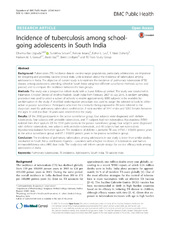Incidence of tuberculosis among school-going adolescents in South India
Uppada, Dharma R.; Selvam, Sumithra; Jesuraj, Nelson; Lau, Esther L.; Doherty, T. M.; Grewal, Harleen; Vaz, Mario; Lindtjørn, Bernt
Peer reviewed, Journal article
Published version

Åpne
Permanent lenke
https://hdl.handle.net/1956/12531Utgivelsesdato
2016-07-26Metadata
Vis full innførselSamlinger
Originalversjon
https://doi.org/10.1186/s12889-016-3342-0Sammendrag
Background: Tuberculosis (TB) incidence data in vaccine target populations, particularly adolescents, are important for designing and powering vaccine clinical trials. Little is known about the incidence of tuberculosis among adolescents in India. The objective of current study is to estimate the incidence of pulmonary tuberculosis (PTB) disease among adolescents attending school in South India using two different surveillance methods (active and passive) and to compare the incidence between the two groups. Methods: The study was a prospective cohort study with a 2-year follow-up period. The study was conducted in Palamaner, Chittoor District of Andhra Pradesh, South India from February 2007 to July 2010. A random sampling procedure was used to select a subset of schools to enable approximately 8000 subjects to be available for randomization in the study. A stratified randomization procedure was used to assign the selected schools to either active or passive surveillance. Participants who met the criteria for being exposed to TB were referred to the diagnostic ward for pulmonary tuberculosis confirmation. A total number of 3441 males and 3202 females between the ages 11 and less than 18 years were enrolled into the study. Results: Of the 3102 participants in the active surveillance group, four subjects were diagnosed with definite tuberculosis, four subjects with probable tuberculosis, and 71 subjects had non-tuberculous Mycobacteria (NTM) isolated from their sputum. Of the 3541 participants in the passive surveillance group, four subjects were diagnosed with definite tuberculosis, two subjects with probable tuberculosis, and 48 subjects had non-tuberculosis Mycobacteria isolated from their sputum. The incidence of definite + probable TB was 147.60 / 100,000 person years in the active surveillance group and 87 / 100,000 person years in the passive surveillance group. Conclusion: The incidence of pulmonary tuberculosis among adolescents in our study is lower than similar studies conducted in South Africa and Eastern Uganda – countries with a higher incidence of tuberculosis and human immunodeficiency virus (HIV) than India. The study data will inform sample design for vaccine efficacy trials among adolescents in India.
